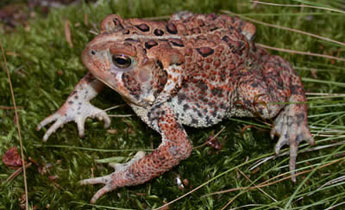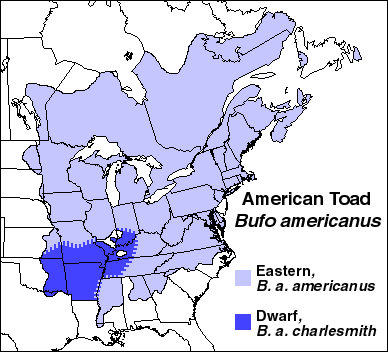American toad
American toad(Anaxyrus americanus): the American toad is a common toad species that can be found throughout the Eastern and Central parts of the United States and Canada.

Description
The American toad is a medium size toad that grows up to 5-9 cm or 2-4 inches in length. Its coloration can change with the humidity and temperature. Predominantly brown, it can have hues of red or olive green. Noticeable warts on its skin, two large ones behind their eyes. These bumps behind their eyes are their parotoid glands that can secrete a bufotoxin, that is used to deter predators. Their bellies are whitish or yellow, usually with dark spots. Females are slightly larger than males.
Range and Subspecies
 These toads can be found throughout most of the Eastern and Central parts of the United States and Canada. It prefers cool woodlands with lots of moisture, but can live in meadows, fields, and gardens. There are thought to be three different subspecies of the American toad. There are currently two subspecies of the American toad, the Eastern American toad (Anaxyrus americanus) and the Dwarf American toad (A. a. charlesmithi). The range of the Dwarf American Toad is more concentrated.There has been some hybridization with the Woodhouse's toad (Anaxyrus woodhousii) when there is range overlap, which is native to the Central United States
These toads can be found throughout most of the Eastern and Central parts of the United States and Canada. It prefers cool woodlands with lots of moisture, but can live in meadows, fields, and gardens. There are thought to be three different subspecies of the American toad. There are currently two subspecies of the American toad, the Eastern American toad (Anaxyrus americanus) and the Dwarf American toad (A. a. charlesmithi). The range of the Dwarf American Toad is more concentrated.There has been some hybridization with the Woodhouse's toad (Anaxyrus woodhousii) when there is range overlap, which is native to the Central United States
Life Cycle and Behavior
Depending on temperature and location, mating can being as early as March and ends in July. The males will find a shallow spot in wetlands or ponds and call to attract females. The males generally only call at night but will call during wet days during the peak of mating season. [1] Once the mating takes place the female will lay from 2,000- 20,000 eggs in a long strand. The eggs will hatch after 3-12 days. The eggs hatching usually happens from June to August. Once the eggs hatch